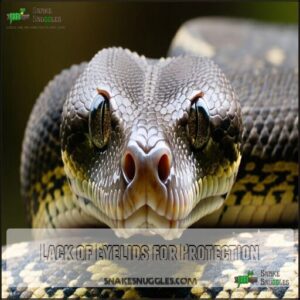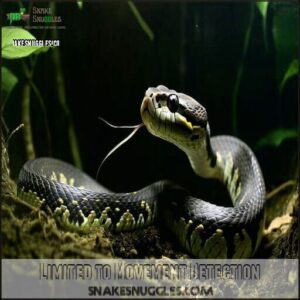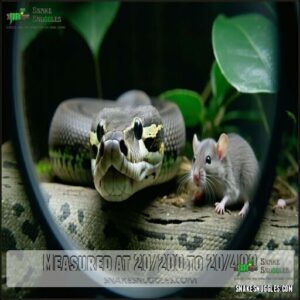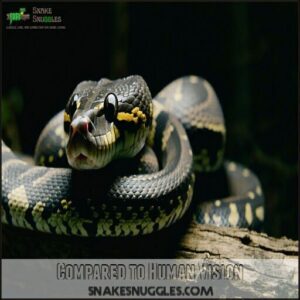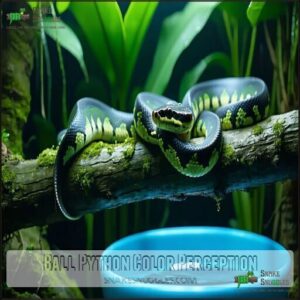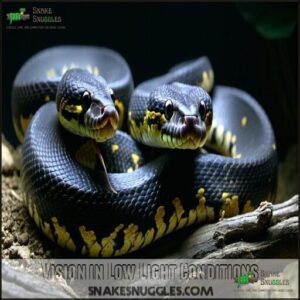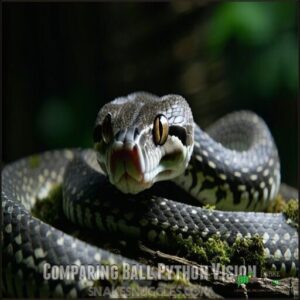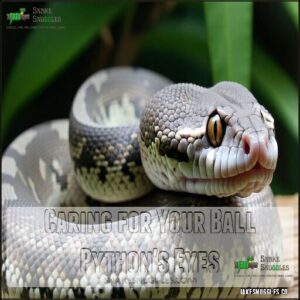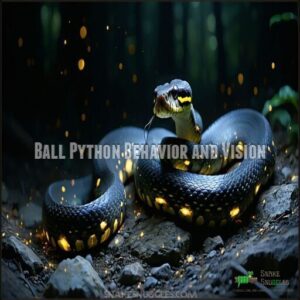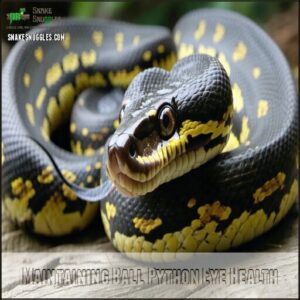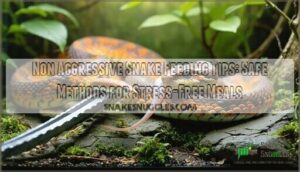This site is supported by our readers. We may earn a commission, at no cost to you, if you purchase through links.

Their vision is adapted for detecting movement, particularly in low light, thanks to the high number of rod cells in their retinas.
While they’re not spotting intricate details or bright colors—they mostly see in shades of gray—they make up for this with other senses like smell and heat detection.
Their vertical pupils help control light exposure, but their visual sharpness measures between 20/200 and 20/400, meaning they’d fail most vision tests!
You’ll find their infrared-sensing pits fascinating, though—a true superpower for detecting warm prey in the dark.
Table Of Contents
- Key Takeaways
- Ball Python Eye Anatomy
- Ball Pythons’ Visual Acuity
- Ball Python Color Perception
- Vision in Low Light Conditions
- Comparing Ball Python Vision
- Caring for Your Ball Python’s Eyes
- Ball Python Behavior and Vision
- Ball Pythons’ Interaction With Humans
- Maintaining Ball Python Eye Health
- Unique Aspects of Ball Python Vision
- Frequently Asked Questions (FAQs)
- Do ball pythons have eyesight?
- Can ball pythons see at night?
- How do ball pythons see the world?
- Can ball pythons see colors?
- Do ball pythons need light?
- Do ball pythons need eye care?
- Do ball pythons have good vision?
- Do ball pythons have eye problems?
- Do ball pythons have eyelids?
- How do you know if a ball python is healthy?
- Conclusion
Key Takeaways
- Ball pythons don’t have sharp vision but excel at detecting motion and contrasts, especially in low light.
- They see in shades of gray with limited color perception, focusing on blue and green hues.
- Heat-sensing pits help them detect warm prey, making them effective hunters in the dark.
- Their eyes are protected by clear scales called brilles, which shed along with their skin.
Ball Python Eye Anatomy
When looking at a ball python’s eyes, you’ll notice their unique design that supports their nocturnal lifestyle.
From vertical pupils adjusting light intake to protective scales instead of eyelids, their anatomy is all about survival in the dark.
Vertical Pupils for Controlling Light
Ever wonder why ball pythons have vertical pupils?
These fascinating predators use their unique pupil shape to adapt to different lighting, enhancing their nocturnal adaptation. The slit-like pupils give them an edge in low-light environments by precisely controlling how much light enters their eyes.
- Improves light sensitivity for spotting prey in the dark.
- Boosts predator vision at night over long distances.
- Sacrifices depth perception and detail for movement detection.
Their vision truly suits their nocturnal lifestyles!
Lack of Eyelids for Protection
Ball pythons don’t have eyelids; instead, their eyes are covered by tough, transparent brilles (eye caps), acting like built-in goggles. These serve important functions:
Brilles protect ball python eyes like clear armor, shielding them from debris and damage while maintaining their sleek, mysterious look.
- Eye Cap Function: Protects against debris.
- Snake Shedding: Brilles shed with skin but can cause shedding complications.
- Infection Risk: Damaged brilles may expose eyes.
- Humidity Effects: Low humidity risks eye opacity or cloudiness.
Retina Composition for Motion Detection
A snake’s survival hinges on its eyes, and a ball python’s retina is purpose-built for motion detection, not detailed imagery.
With rod concentration dominating over cones, they excel at spotting movement in low light but miss fine details.
Their elliptical pupils enhance light intake, while a low flicker fusion rate aids in tracking slow-moving prey.
Combined with UV sensitivity and peripheral vision, these traits make their vision perfectly suited for nocturnal hunting.
- Key Features:
- Optimized for movement, not detail
- Enhanced night vision from rod-dominant retinas
- Elliptical pupils for variable light conditions
- Peripheral vision complements limited depth perception
- UV sensitivity aids prey detection in the dark
Ball Pythons’ Visual Acuity
You’d be surprised to learn just how limited a ball python’s eyesight is, as their vision is designed more for detecting movement than seeing details.
With a visual acuity estimated between 20/200 and 20/400, they see the world as a blur compared to human standards.
Limited to Movement Detection
Regarding movement detection, ball python vision truly shines.
Their eyes are like finely tuned motion sensors, designed to spot even the slightest flicker—a huge survival advantage.
Whether tracking prey or evading threats, this ability keeps them sharp in low-light environments.
They don’t rely on visual details; instead, they excel at detecting motion and contrasts.
Imagine their world as a grayscale movie, focused on anything moving across the screen.
This unique hunting behavior makes them formidable nocturnal predators, combining environmental awareness with precise prey tracking.
For ball pythons, motion detection guarantees success where visual clarity falls short.
Measured at 20/200 to 20/400
Measured on the visual acuity scale at 20/200 to 20/400, a ball python’s eyesight is a bit like looking through fogged glasses.
They’re great at detecting movement, especially in low light, but don’t expect sharpness. Their prey detection relies on motion rather than fine details. This unique snake eyesight supports their nocturnal ambush skills.
- Key traits of python eyesight:
- Limited sharpness for distant objects
- Enhanced motion detection
- Excellent low-light vision
- Infrared enhancement for prey tracking
- Impacted by environmental conditions
Compared to Human Vision
Regarding snake vision, ball python eyesight greatly differs from ours.
Their visual acuity, measuring around 20/200 to 20/400, makes their world blurrier than what humans experience. Instead of detailed images, they’re pros at motion detection and spotting contrasts, especially in low-light settings.
While you see vibrant colors and depth, ball python vision is tuned to light sensitivity and limited color perception. Think of them as nighttime specialists, not art critics.
Their vision is supplemented by specialized heat-sensing pits that detect infrared radiation.
Here’s a quick comparison:
| Feature | Humans | Ball Pythons |
|---|---|---|
| Visual Acuity | 20/20 | 20/200-20/400 |
| Color Perception | Trichromatic | Dichromatic |
| Depth Perception | High | Low |
| Light Sensitivity | Moderate | High |
| Motion Detection | Moderate | Excellent |
Ball Python Color Perception
You might be surprised to learn that ball pythons don’t see color the same way you do.
Their vision is limited to shades of blue and green, which helps them adapt to their nocturnal lifestyle.
Structure of The Eye Limiting Color Vision
You’ve probably wondered how ball python vision works. Their eye structure prioritizes motion detection over vivid colors because their retina is rod-dominated.
This means they see a limited range of hues through dichromatic vision, focusing on the blue and green spectrum.
Here’s why vision’s limited:
- Rod-heavy retinas
- Cone types for limited hues
- High motion sensitivity
- Night-time optimization
- Degree of colorblindness
Seeing in Shades of Gray
Ball python vision operates in greyscale, a result of their dichromatic eyes.
With rod dominance over cones, they excel in lowlight vision but have limited detail and motion priority, perfect for nighttime hunting.
Unlike color-rich human eyesight, their vision focuses on movement and contrast.
This nocturnal advantage makes snake eyesight quality unique, though ball python visual acuity is obviously low.
Detection of Infrared Radiation for Heat
Imagine having a built-in thermal camera—that’s what ball pythons rely on for hunting. Their heat-sensing skills come from labial pits along their jaws, which detect infrared radiation emitted by warm-blooded prey. This enables them to “see” heat, even in darkness, ensuring thermal image accuracy.
Their pit organ function is fundamental when light alone won’t cut it. Ball pythons also possess excellent low-light vision.
Here’s how it works:
- Infrared hunting range: They detect heat up to 30 cm away.
- Prey detection methods: Combine heat sensing with motion tracking.
- Environmental temperature impact: Helps identify moving targets in cool surroundings.
This extraordinary infrared perception is a game-changer for their nocturnal hunting.
Vision in Low Light Conditions
You might think living in the dark would be a challenge, but ball pythons are built for it.
Their eyes are packed with rod cells, letting them detect motion and subtle contrast even in dim light.
Making them efficient nighttime hunters.
Adaptations for Hunting at Night
When the sun sets, ball pythons become stealthy predators adapted to shadowy environments. Their nocturnal abilities stem from keen sensory integration, allowing them to track prey even in near darkness.
With a retina packed with rod cells, they excel at low-light contrast, focusing on subtle movement.
Heat-sensing labial pits add another layer of accuracy, detecting infrared radiation from warm-blooded prey. This sensory advantage creates a thermal map of their surroundings, following heat signatures like a radar.
- Heat pit accuracy pinpoints prey quickly.
- Low-light contrast detects movement in dim settings.
- Sensory integration blends vision and heat sensing for success.
Enhanced Motion Detection in Darkness
When it’s dark, ball python vision capabilities shine.
With a high rod concentration dominating their retinas, these snakes excel at spotting motion in near-total darkness.
Their nocturnal movement perception is so fine-tuned, they can catch the tiniest twitch of prey.
Elliptical pupils let in all possible light, greatly enhancing contrast detection.
Combined with low flicker fusion, they focus on subtle, slow movements like a seasoned tracker.
Peripheral awareness also comes into play, helping with low-light hunting accuracy.
Importance of Smell in Hunting
Regarding hunting, ball python senses go far beyond their limited eyesight. Their secret weapon? Smell.
Using a process called olfactory hunting, they rely on their forked tongue to collect chemical cues floating in the air. Every tongue flick is like scanning the environment, with these signals sent to the Jacobson’s organ (vomeronasal organ) for interpretation.
This ability gives ball pythons a knack for scent tracking, helping them pinpoint prey like rodents, even in pitch black. It’s almost like carrying a built-in GPS for prey location.
- Tongue flicking: Gathers airborne chemical cues.
- Chemical cues: Paint a "scent map" of surroundings.
- Scent tracking: Guides them straight to hidden meals.
This impressive sensory perception guarantees successful, efficient hunts.
Comparing Ball Python Vision
When you compare a ball python’s sight to other snakes like boas or rattlesnakes, you’ll notice some key differences.
While boas excel in color detection and rattlesnakes rely on heat-sensing facial pits, ball pythons have unique visual adaptations that suit their nocturnal and ambush hunting style.
Boas’ Advanced Eyes for Color Detection
Boas outshine ball python eyesight with impressive color vision capabilities. Thanks to advanced cone cell types, they detect a broader color range, including blue and green. Their evolutionary eye development offers superior clarity.
- Boa Color Vision: Vibrant hues improve awareness.
- Diurnal Vision Advantages: Sharp clarity aids daytime hunting.
- Balanced Sight: Supports both nocturnal and diurnal activity.
Rattlesnakes’ Heat-Sensing Facial Pits
Rattlesnakes are like nature’s night vision experts, thanks to their incredible pit organs, located between their eyes and nostrils.
These organs sense infrared radiation, allowing them to detect even the slightest heat variations in their surroundings. Imagine having a built-in thermal camera—you’d never miss a warm-blooded snack!
Their thermal imaging accuracy is so advanced that they can effortlessly track prey in total darkness, striking with pinpoint precision.
Unlike ball pythons, rattlesnakes excel in sensory integration, combining their heat-sensing and vision for ultimate hunting efficiency.
This evolutionary advantage makes them formidable predators, perfectly equipped for locating prey no matter the lighting—or lack thereof—in their environment.
Ball Pythons’ Unique Visual Adaptations
Ball python vision isn’t the sharpest, but it’s customized for their nocturnal hunting.
Their vertical pupils act like built-in sunglasses, adjusting to let just the right amount of light in. While they don’t see in vivid colors, their dichromatic vision helps them detect blue and green hues.
Combined with motion sensitivity, they’re like living motion detectors, spotting prey with ease.
Heat-sensing pits add another layer, painting a thermal "map" perfect for night hunts. Plus, their UV light sensitivity might aid prey detection.
- Detects movement even in dim light
- Relies less on color, more on contrast
- Low-light hunters with thermal "vision"
- Built for underground ambushes
- Eyes protected by durable spectacles
Caring for Your Ball Python’s Eyes
Taking care of your ball python’s eyes is essential to its overall health and well-being, as their vision plays a secondary but important role in daily behavior.
Make sure to provide the right lighting, monitor for any signs of infection, and guarantee proper shedding to keep those fascinating eyes in great shape.
Providing Proper Lighting and Temperature
Good lighting and proper temperatures are vital for your ball python’s health and vision.
Use low UVB lighting to simulate natural light cycles and enhance reptile eyesight.
Maintain temperature gradients of 75-90°F in zones around the enclosure with basking spots and nighttime heat options.
Add a balanced mix of ambient light for resting.
You may need to research specialized python illumination for advantageous health.
Here’s a quick guide:
| Lighting Type | Temperature Zones |
|---|---|
| Low UVB light bulbs | 75°F cool areas |
| Ambient lighting | 85°F activity zone |
| Avoid bright glare | 90°F basking spot |
Superior ball python care guarantee their vision and heat-sensing abilities stay first-rate!
Avoiding Direct Sun Exposure
Guaranteeing your ball python avoids direct sunlight is key to proper snake care.
Their light-sensitive eyes can suffer UV damage, causing long-term issues.
To keep your pet happy and safe, try these practical tips:
- Provide ample shade: Position the enclosure where it won’t get direct sunlight, focusing on shade requirements.
- Filter UV rays: Install UV-blocking window films to protect against harmful exposure.
- Add hides: Include multiple hiding spots for your python to escape bright light, avoiding thermal overload.
Proper enclosure placement and UV safety guarantee healthier eyes and better ball python care overall.
Monitoring Eye Health and Hygiene
Keeping your ball python’s eyes healthy is simpler than you think, but it takes consistency.
Always check for shedding issues, like retained eye caps, or signs of eye infections, such as cloudy eyes or unusual discharge.
Balanced humidity keeps their sensitive eyes healthy—too dry, and problems arise.
Regular enclosure hygiene also prevents bacteria growth.
If you notice anything unusual, consult a vet to rule out snake eye diseases or injuries.
For maintaining best hygiene, consider a suitable cleaning solution.
Here’s a quick guide:
| Concern | What to Watch For | Prevention Tip | Home Action | Veterinary Advice |
|---|---|---|---|---|
| Shedding Issues | Retained eye caps | Maintain humidity | Mist enclosure lightly | Seek vet removal help |
| Eye Infections | Redness/discharge | Guarantee hygiene | Use sanitized tools | Medication when necessary |
| Eye Caps | Cloudy appearance | Moisturize environment | Regular humidity checks | Contact vet for advice |
| Vision Problems | Infrequent strikes | Prevent stress | Adjust tank lighting | Examination recommended |
| Snake Eye Diseases | Swollen tissues | Monitor daily changes | Improve diet, hydration | Treat infection early |
Daily care guarantees your snake’s vision stays sharp!
Ball Python Behavior and Vision
You’ll notice ball pythons rely on sharp instincts more than sharp eyesight, using movement detection and contrast to interpret their surroundings.
Their vision, though limited, works perfectly with their heat-sensing abilities to help them hunt and survive at night.
Detecting Movement and Contrast
Your ball python’s vision is great at spotting movement, even in low light.
Thanks to their retina, packed with rod cells, they’ve mastered motion sensitivity.
Their contrast perception helps them detect subtle shifts in shadows or outlines, useful for ambush predation.
While flicker fusion (how they process moving light) isn’t as fast as yours, it works well for their nocturnal lifestyle.
They rely on visual cues like contrast changes to track prey efficiently, ensuring their hunting skills are sharp even at night.
Limited Peripheral Vision
Ball python vision capabilities include limited peripheral vision, which means they experience noticeable blind spots. Their monocular vision narrows their visual field, forcing them to rely on movements within direct sight.
Depth perception, important for strike accuracy, is stronger in front but weaker to the sides.
Here’s how blind spots affect behavior:
- They miss side movements easily.
- Directly face areas to gauge depth.
- Rely on motion for enclosure awareness.
- Hunting strategies exploit movement.
- Vision prioritizes focus over coverage.
Limited peripheral vision
Rely on motion
Gauge depth
Exploit movement
Adaptations for Hunting and Survival
How do ball pythons thrive as nocturnal hunters despite poor eyesight? They rely on finely tuned sensory abilities and ambush tactics. These evolved senses make them formidable predators when the lights go out.
Here’s how they master prey detection in the dark:
- Heat sensing: Their infrared radiation-detecting pit organs spot warm-blooded prey like mice in complete darkness.
- Sensory reliance: By combining smell and heat sensing, they identify prey size and location with impressive accuracy.
- Ambush tactics: A sudden, lightning-fast strike makes certain they rarely miss a meal.
- Nocturnal advantage: Whether maneuvering narrow burrows or open ground, they’ve adapted perfectly to a life where others stumble blindly.
Ball Pythons’ Interaction With Humans
When interacting with your ball python, it’s important to understand that their eyesight isn’t their strongest sense.
They rely more on movement, smell, and heat detection, so handling and consistent interaction play a bigger role in building trust.
Recognizing Human Faces and Voices
Your ball python’s eyesight isn’t sharp enough for facial recognition, but it doesn’t need it to recognize you.
Their voice discrimination skills, paired with sound perception between 200-300 Hz, help them respond to familiar voices.
Combine this with their enhanced sense of smell, and they create learned associations that foster human interaction.
Ball pythons can detect sounds through ground-borne vibrations, as they lack external ear openings.
Over time, your python bonds with you through domestication effects and handling—proof it knows you in its unique, sensory-driven way.
| Sense | Strength | How It Helps |
|---|---|---|
| Eyesight | Weak, poor facial recognition | Aids in motion detection |
| Smell | Highly developed | Recognizes owner’s scent |
| Sound Perception | Sensitive to specific tones | Detects familiar human voices |
Limited Response to Visual Stimuli
Your ball python’s eyesight isn’t built for clear details, so don’t expect it to gaze longingly at you! Their vision capabilities favor detecting motion over static objects, which is key for ambush hunting. Movement priority and a low stimuli threshold mean they rely more on heat and scent to respond.
Why do visual cues fall flat?
- Visual acuity is poor, so distant objects blur into the background.
- Their prey response depends on heat detection rather than sight.
- Static objects don’t register unless they involve movement.
- Environmental impact affects what they see—light, shadows, and contrast matter.
They’re specialists, not spectators!
Importance of Handling and Socialization
To build trust with your ball python—despite their limited eyesight—it’s key to focus on their other senses, like touch and smell, while respecting their unique behavior.
Socialization methods can reduce stress and enhance snake behavior, creating a calm and confident pet.
Here’s how:
- Wait 48-72 hours after feeding to prevent stress or regurgitation.
- Provide full-body support, respecting natural movements to build trust and reduce stress.
- Handle briefly and frequently so they gradually adjust to your presence and scent.
Nobody likes handling right after dinner!
Think of it as their version of a spa day.
Consistent handling benefits both you and your snake, fostering enrichment activities and strengthening your bond over time.
Maintaining Ball Python Eye Health
To keep your ball python’s eyes healthy, you’ll need to monitor for signs of irritation, shedding issues, or infections.
Providing proper humidity, clean enclosures, and regular vet check-ups helps prevent problems and guarantees clear vision.
Signs of Eye Problems and Infections
Your snake’s eyes can hint at their overall health, so it’s worth keeping an eye out (pun intended!).
Problems like cloudy eyes, discharge symptoms, swollen eyes, or retained caps can signal underlying issues. Retained eye caps, for instance, may feel like having an eyelash stuck in your eye—annoying and potentially harmful.
A common issue to watch for is dermatitis and irritation, which can affect the skin around the eyes.
Here’s a table to help you:
| Symptom | Possible Cause | Suggested Action |
|---|---|---|
| Cloudy eyes | Retained caps | Increase humidity |
| Discharge | Infection | Schedule a vet visit |
| Swollen eyes | Injury signs | Seek veterinary advice |
| Sunken eyes | Dehydration | Adjust enclosure humidity |
| Persistent symptoms | Underlying illness | Consult a specialist |
Regular health checks can prevent vision problems and keep your ball python’s eye health in top condition.
Importance of Proper Shedding and Hydration
Healthy shedding is a big deal for your ball python’s skin and eye health.
Without proper humidity, shedding problems like retained eye caps can lead to vision impairment and discomfort.
Aim for hydration levels of 55-70%, but bump it to 80% when you spot cloudy eyes signaling an upcoming shed.
A humid hide with damp moss or a warm-side water dish works wonders for humidity control.
Maintaining proper humidity levels is key for their well-being.
These steps guarantee smooth shedding and clear snake eye health.
Remember, stuck eye caps aren’t just annoying—they can block vision and cause irritation.
With proper care, you’re keeping your python healthy, comfortable, and free from shedding worries, all while protecting their delicate eyesight!
Regular Veterinary Check-Ups
Scheduling regular veterinary check-ups is a cornerstone of maintaining ball python health and keeping their eyes in tip-top shape.
Experienced snake veterinarians can spot early signs of infections, shedding issues, or other snake eye problems that might otherwise go unnoticed. Think of these visits as your python’s wellness check—they evaluate hydration, respiratory health, and overall scale and eye care.
During an exam, your vet guarantees proper parasite prevention, evaluates their habitat and diet, and catches shedding or hydration issues before they snowball into bigger concerns. It’s all about proactive snake health.
Plus, a trusted snake veterinarian is your ally in giving your python the best care possible, guaranteeing they live a long, healthy life while slithering happily with clear vision and strong scales! Think of these visits as your python’s wellness check—they evaluate hydration, respiratory health, and overall scale and eye care. Experienced snake veterinarians can spot early signs of infections, shedding issues, or other snake eye problems that might otherwise go unnoticed.
Unique Aspects of Ball Python Vision
When you think about vision, ball pythons might surprise you with how different their eyes work compared to ours.
From sensing infrared heat to adapting for life underground, their unique vision is perfectly suited to their nocturnal, ambush-predator lifestyle.
Infrared Detection and Heat Sensing
Ever wonder how your ball python thrives in total darkness? It’s all thanks to their pit organs—tiny, specialized heat sensors.
Their pit organs light the way in darkness, sensing heat and turning invisible prey into an easy, precise target.
Here’s how these organs, powered by infrared detection, work wonders:
- Pinpoint prey: Thermoreceptors detect body heat within a short range, even in pitch dark.
- Thermal accuracy: Create detailed, heat-based maps of their surroundings for precise navigation.
- Perfect strike timing: Guides their movement, ensuring accurate strikes against warm-blooded prey.
This remarkable heat sensing evolution allows them to hunt effectively, despite poor eyesight, proving temperature truly lights the way!
Limited Visual Acuity and Color Perception
Ball python vision capabilities are a bit like watching an old, grainy movie—they’re short-sighted with limited focus on detail or color. Their dichromatic vision offers minimal perception of the color spectrum, mostly shades of blue and green, leaving reds and yellows a mystery.
However, they’re built for motion sensitivity rather than sharpness.
Here’s what defines their visual acuity:
- They rely on movement tracking, not fine details.
- Rods dominate, enhancing light sensitivity.
- Visual dependence is low due to poor clarity.
- Adaptations make color perception secondary.
Adaptations for Underground and Nocturnal Lifestyle
As a ball python, you’ve got sensory compensation that suits your nocturnal lifestyle perfectly.
Your light sensitivity shines through with vertical pupils limiting glare, while brille scales shield your snake eyes like built-in goggles.
Though your limited acuity means you can’t see far, your incredible motion detection makes every rustle count at night.
Hunting isn’t just about sight, though—your heat-sensitive pits are key to prey detection, letting you sense infrared "heat maps" even in pitch dark.
Here’s a quick breakdown of your visual adaptations:
| Adaptation | Purpose | Benefit |
|---|---|---|
| Vertical Pupils | Control light entry | Enhanced low-light vision |
| Brille Scales | Protect eyes | Avoids scratches or damage |
| Heat-Sensitive Pits | Detect infrared | Perfect for tracking prey |
For a creature of the dark, snake vision fits the job.
Frequently Asked Questions (FAQs)
Do ball pythons have eyesight?
Their eyesight mightn’t win any awards—it’s short-sighted and tuned for movement rather than detail.
While they see best in low light, they rely far more on heat sensing and smell to navigate their world.
Can ball pythons see at night?
They can see at night, but don’t expect eagle-like vision.
Their eyes are adapted for low light, spotting movement and contrasts.
Combined with heat-sensing pits, they’re pretty effective hunters, even in the dark.
How do ball pythons see the world?
Seeing through a ball python’s eyes is like viewing the world in a dim, grayish-blue haze.
They rely on movement, contrasts, and heat detection, while their limited color vision focuses mostly on blues and greens.
Can ball pythons see colors?
These snakes can perceive some colors, primarily blue and green, thanks to their dichromatic vision.
While they won’t paint rainbows anytime soon, their limited color range works just fine for nocturnal hunting and survival.
Do ball pythons need light?
Think of light as a ball python’s guide, not their lifeline.
They don’t need bright lights but benefit from a natural day-night cycle.
Soft lighting helps regulate their rhythms, mimicking their wild, underground lifestyle.
Do ball pythons need eye care?
Ball pythons don’t need much eye care, but watch for issues like cloudy eye caps after shedding or signs of infection.
Keep their habitat clean, humid, and stress-free to support their overall eye health.
Do ball pythons have good vision?
Ball pythons don’t have sharp vision.
They see movement and light contrast well but lack detail and depth perception.
Their vision works alongside heat-sensing pits and smell, making them effective nighttime hunters despite poor eyesight.
Do ball pythons have eye problems?
Your ball python’s eyes can occasionally have issues, like retained eye caps after shedding or infections.
It’s important to monitor them regularly, as clear, healthy eyes are essential for their overall well-being and sensory balance.
Do ball pythons have eyelids?
They don’t have eyelids like you do.
Instead, their eyes are covered by clear protective scales called eye caps, or brilles, which they shed along with their skin.
It’s a clever built-in shield!
How do you know if a ball python is healthy?
A healthy ball python has clear eyes, smooth skin, steady breathing, and a good appetite.
It should be active at night, responsive to handling, and have no visible injuries or discharge around its mouth or vents.
Conclusion
It’s safe to say ball pythons won’t be winning any vision contests!
Their eyesight, though far from sharp, is perfectly designed for their survival.
While they don’t see colors or fine details, they excel at detecting movement and heat—a superpower in the animal kingdom.
If you’re wondering, “Do ball pythons have good eyesight?” the answer lies in perspective: it’s not about clarity but efficiency.
Their world, in shades of gray, is all they need to thrive.
- https://www.berrypatchfarms.net/ball-python-vision/
- https://www.monsterfishkeepers.com/forums/threads/snakes-vision-hearing.38079/
- https://www.aussiepythons.com/threads/how-good-are-snakes-eyesight.148352/
- https://ball-pythons.net/forums/showthread.php?236480-Intelligence-and-eyesight
- https://journals.biologists.com/jeb/article/202/14/1931/8052/The-photoreceptors-and-visual-pigments-in-the


